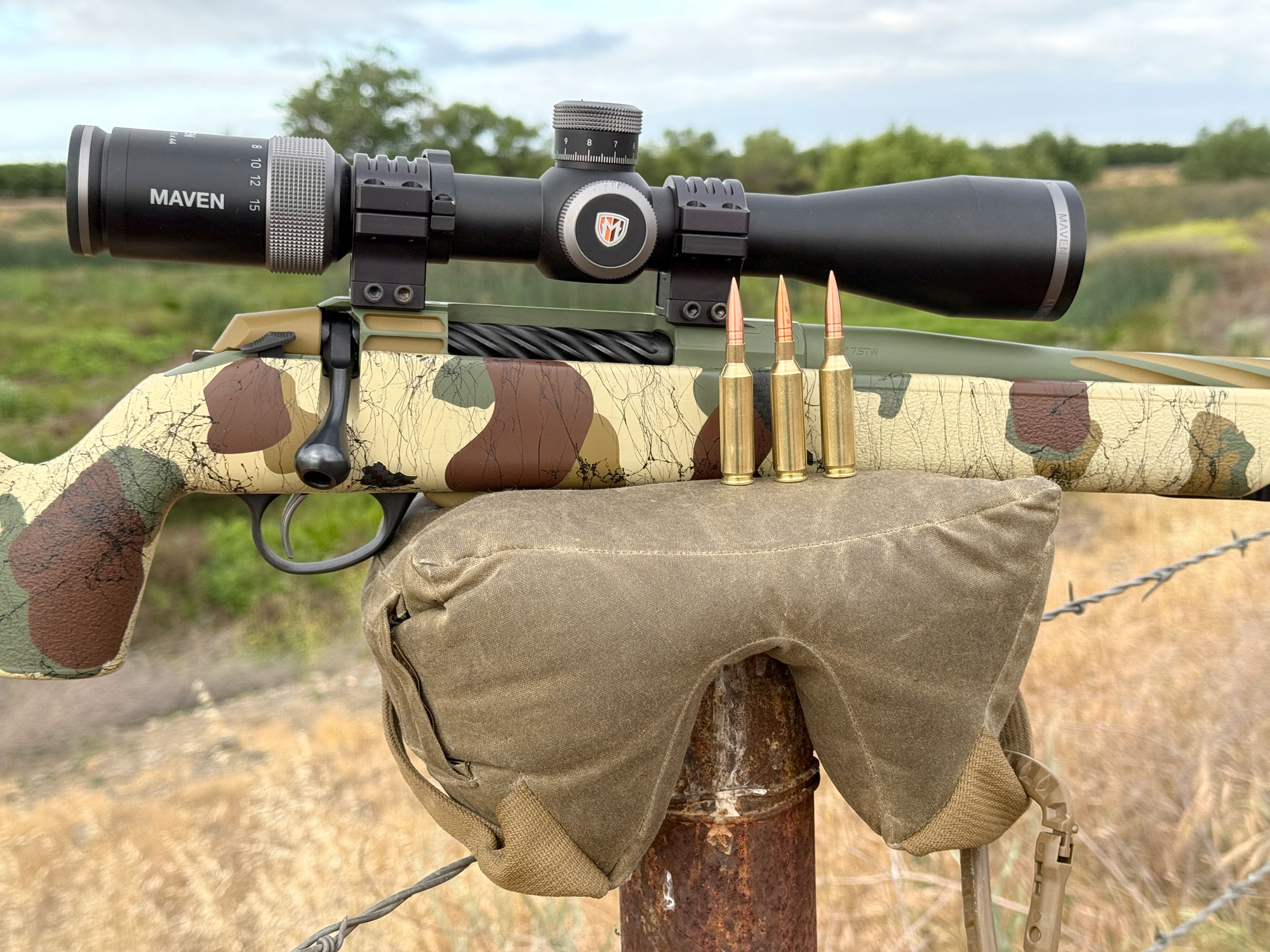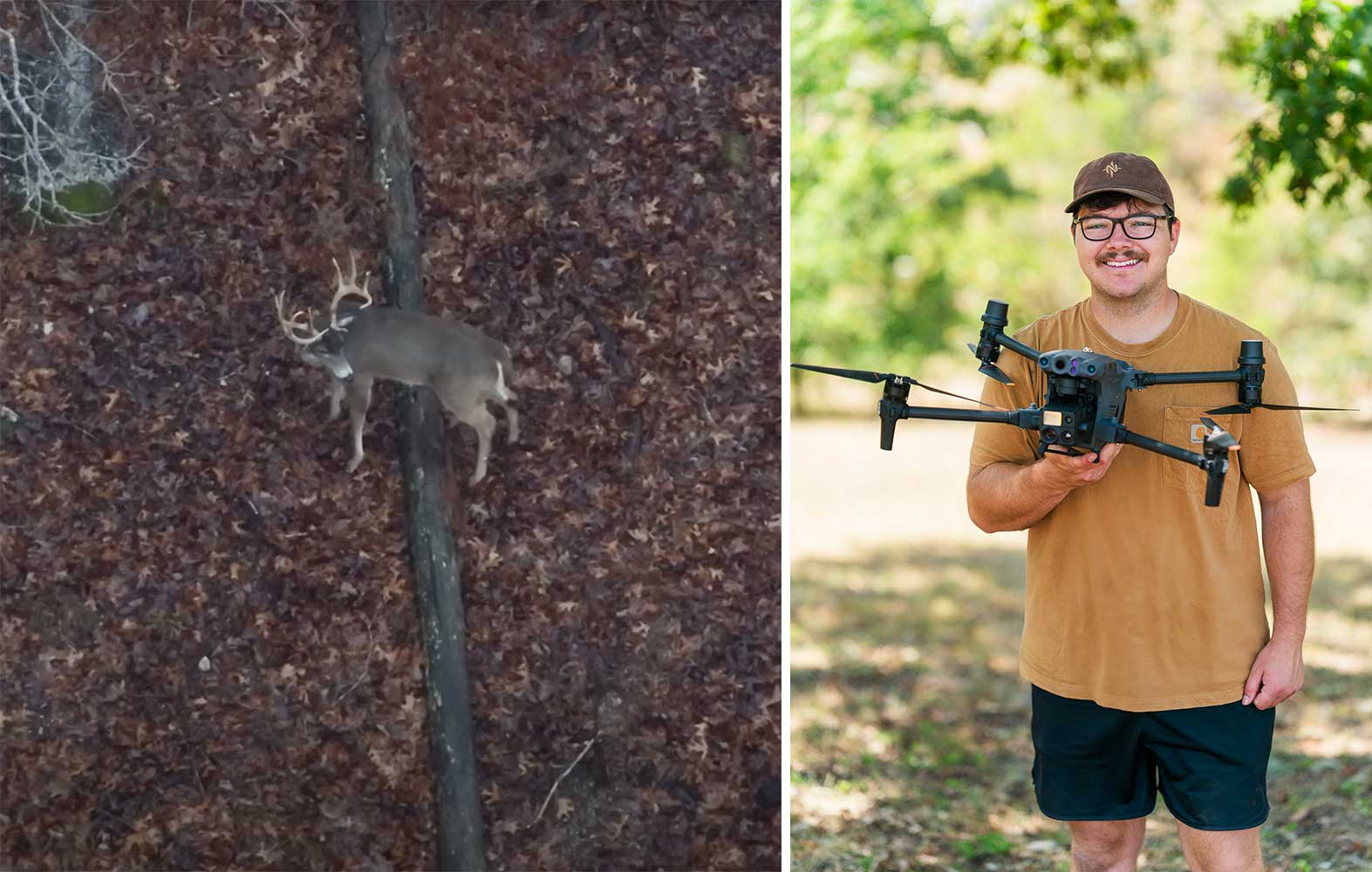McGuire Ballistics Copper Rose Bullets Produce Better BCs and Devastating Terminal Performance

I almost couldn’t believe what I was seeing as my knife split the inch-and-a-half-thick gristle plate of a large California boar. My blade bisected the tiny 6mm entrance hole, a fortunate accident, and revealed a perfect cross section of the initial wound cavity. A caliber-sized neck — the portion of a wound cavity after entrance before the bullet starts expanding — extended through the armor plate then rapidly widened as the bullet hit soft tissue beneath. It ultimately left a two-inch-diameter entry into the ribcage, massive wound channel through the lungs, and a one-inch exit. Each of the other six 200-plus-pound pigs we’d killed in the past two days told the same story. The McGuire Ballistics Copper Rose is not your traditional copper bullets.
The Campaign for Copper
Hunters have debated the virtues and drawbacks of monolithic copper bullets for many years. The State of California, and numerous other places have either banned or pushed to ban hunting ammunition that contains lead. This is an attempt to protect scavengers and birds of prey from lead poisoning due to ingesting fragments left in gutpiles. The same argument is also made for preventing people from being exposed to lead in wild game. Some of this is heavily shaded with anti-hunting motivation, but not entirely. A number of agencies and organizations have offered rebate-like deals for hunters who choose to buy copper hunting ammunition.
Some prolific hunters and writers have even advocated for copper bullets based on the performance characteristics of what I’ll call traditional copper bullet designs — think Barnes TSX/TTSX/LRX or Hornady GMX/CX. At sufficient velocity, these bullets consistently mushroom with petals peeling back and offer great penetration on heavy game. Some of the most common arguments in favor of copper bullets are as follows:
- Not a danger to scavengers
- Consistent, controlled expansion
- Near 100 percent weight retention
- Deep penetration
Common Disadvantages of Copper Bullets
If the matter were cut-and-dry, there would be no debate, but copper bullets historically have had some significant drawbacks too. Here are a few of the most common valid complaints about copper projectiles:
- Smaller wound channels/ they often don’t kill as quickly as lead-core bullets
- Generally not as accurate
- Ballistic coefficients aren’t as good as lead-core bullets in the same caliber
- Shorter effective range — they need more velocity to work properly
All of these points can be debated, and are sometimes exaggerated, but there is some truth to each. I have killed many animals over the years with monolithic bullets and never had an unsatisfactory outcome that I could blame on anything other than my own shooting. I shot my first two bears, one is still the biggest black bear I could ever hope to bag, with the old blue-coated Barnes X bullets, followed by multiple moose, caribou, bears, deer, mountain goat, a bull elk, and more with other Barnes and Hornady copper bullets. When used within their design parameters, they work well.
I have noted that copper bullets do indeed produce smaller wound channels than jacketed lead bullets. One good example of this was a black bear I shot last year. It had just been shot with a bow, and we thought the arrow had missed the chest cavity (it hadn’t). I follow-ed up on him quartering away from about 60 yards, with my .338 Win. Mag. using a 225-grain Hornady GMX at 2,600 fps. The bear flinched at the impact and ran another 70 yards before expiring. It had a roughly 1.25-inch-diameter wound cavity through to the exit with a limited halo of bloodshot tissue directly around the wound channel. We initially mistook the clean, small bullet exit for the broadhead entrance hole and later noted that the arrow had gone through the bottom front of both lungs and the bear likely went farther than he would have if I’d not followed up with the rifle. The next day I shot two more bears with a 6.5mm 143-grain ELD-X at about 2,600 fps and the wounds were much more catastrophic in both cases with the bears expiring more quickly and traveling shorter distances after the shot — about 40 yards each.
As to the other points, I can confirm their general truth from accuracy testing with thousands of rounds and many different cartridges in different rifles. Copper bullets can be extremely accurate, but they are often finicky and lots of factory ammo shoots poorly in most rifles. I’d wager that if the whittling deacons who squawk about their rifles shooting MOA-all-day with copper slugs were to use a valid sample size, their true cone of fire would be less than remarkable.
A New Kind of Copper Bullet
Two factors, generally, cause a lead-core bullet to produce a larger, more devastating wound cavity than standard copper. Because the lead core is much softer and these slugs usually have had either a soft lead or polymer tip to initiate expansion, they open up more rapidly and dramatically than. Rapid expansion will produce larger temporary and permanent wound cavities in the tissue it hits than a bullet that doesn’t expand as much or as fast. The second factor is the fragmentation that happens with that quick, dramatic expansion. Having more pieces of lead and jacket tearing through tissue create more damage than a projectile that retains all its mass.
But what if copper bullets could behave more like that?
Traditional copper bullets are limited by their slower controlled expansion and high weight retention. They still create a permanent wound cavity, but it’s smaller than that of a similar lead-core bullet. In recent years, several different copper bullet makers have developed projectiles that accomplish terminal performance results placing them in an entirely different category than traditional copper bullets. The two biggest things these different designs have in common are violent expansion and a front segment of the bullet which tears or breaks apart into petals that peel off from the shank and create additional wound channels.
Is It A Gimmick?
The first I ever heard of bullets in this category was from my friend Mike Cyrus at Lehigh Defense. I’d contacted him about load data for their 10mm Extreme Penetrator bullet and eventually I got some of their Controlled Chaos rifle bullets to use. They feature a large-diameter hollow point with a deep cavity, which facilitates their “explosive” expansion. I didn’t have to see much before I was convinced of the concept. I’ve seen them work on black bears in .350 Legend, Moose in .300 H&H and .308 Win., and have friends who have used them in .375 Ruger to shoot moose and coastal brown bear. One buddy shot a nice interior Alaska Grizzly bear a week ago with that same 270-grain bullet in his .375 Ruger and told me it produced a wound that blew the heart out the exit side.
Some hunters who are devout lead users argue that it’s not possible for a bullet that doesn’t fragment as much as a cup-and-core slug to inflict damage that dramatic without some sort of oddball behaviour such as tumbling. However, we do know that permanent wound cavities can be pretty dramatic due to hydraulic effects imparted by the bullet. Consider the Black Hills Ammo Honey Badger 10mm load. It uses a non-expanding monolithic 115-grain bullet at 1,600 fps. When I quizzed owner Jeff Hoffman about this choice, he provided calibrated gel testing photos showing a wound cavity Identical to that of a .44 Magnum shooting a 240-grain JHP bullet.
I have a mechanical engineering degree, but still can only speculate about what causes the apparent explosive-like expansion of these copper bullets. It could be an adiabatic compression effect from the cavities in these bullets being instantaneously compressed. That’s a process where a tremendous amount of energy (like the impact of a bullet) is put into the system, and dramatic energy output is the result. You’ll see this effect in slow-mo videos of gel blocks being shot, expanding, then rapidly contracting with a bright flash of light. That’s my current theory. I’ve recovered numerous petals from bullets like this and the thicker-walled fragments are often bulged out rather than peeled backward like a traditional mushrooming bullet. This indicates an incredible amount of pressure inside the cavity which bulged, then blew apart.
Copper in the Golden State
This past winter I was connected with Sam McGuire — owner of McGuire Ballistics and a lifelong hunting guide in central California. He comes from a family of aerospace machining and manufacturing and set out to make a better copper bullet after recognizing consistent issues with the bullets his guided hunters were using. Lead hunting ammo has been outlawed in California, so options are limited. Sam and his buddy and co-guide Colby, take hunters for large trophy pigs year-round. The swine are tough, deceptively-constructed animals and, in his own words, Sam got tired of tracking wounded pigs.
The Copper Rose
I didn’t need convincing of the efficacy of copper bullets that expand violently and shed their petals, but when I received a few sample packs of bullets, I was stumped as to how he makes them. (Spoiler: I still don’t know exactly.) The Copper rose is similar to other mono-metal bullets in that it has relief grooves which give the hard copper somewhere to move when engraved into the rifling, and they have an efficient-looking boat tail. But they look more like a full-metal-jacket bullet than any expanding hunting bullet. Some quick sectioning of one of these bullets revealed that the front end has a very large cavity and sidewalls that taper down to nearly paper thin behind the point. The point is copper and is attached to the end of the bullet seamlessly — it is not like a polymer or aluminum tip that extends back down into the bullet. It appears to be attached rather than drawn, but there are no visible seams.
Field Testing
After some range testing bullets in a few different rifles, I gladly accepted an invitation to join Sam and a couple other writer friends — Colton Bagnoli and Zak May — in California to test the bullets ourselves on trophy pigs. I brought a customized Tikka chambered in 6mm Creedmoor, shooting the 93-grain Copper Rose, but we would also end up shooting pigs with 25 Creedmoor, 25 PRC, 7mm PRC, and .30/30 bullets.
The two-day trip was a blur of early mornings and shooting that was wrapped up before the sun rose, followed by skinning, butchering, and naps — all in time to do it again in the evening. Sam’s and his crew’s experience showed and the hunting was spectacular. At first and last light we stalked and ambushed pigs feeding in a recently cut barley field on the edges of almond and pistachio groves, and during the day we worked Sam’s dogs through a creek bottom. On the second morning I shot one large boar that the dogs bayed in the nearby rolling hills of prairie grass just before sunrise.
Post Mortem: Copper Rose on Game
In total, we shot and cut up seven large pigs, including one I’d first hit too far back and managed a solid follow-up shot, and another that was hit above the spine. In the latter case, we called a high shot and stood ready for the pig to get back up, but petals from the bullet had blown down through the thoracic cavity and cut through the heart. It was still a limited sample size, but bullet performance was very consistent — and somewhat scaled to caliber. This was my first experience cutting up large wild pigs and I was impressed with their construction. I don’t think there’s as dense an animal in North America — or a better one for testing bullet performance.
After returning home, I did some additional accuracy and field testing. My seven-year-old daughter took her first black bear with the .224-inch 71-grain Copper Rose from a 22 ARC, and I shot another with the 93-grain from my 6mm Creedmoor. Even on the soft-bodied black bears, both bullets performed consistently with large wound cavities, petals peeling off through the lungs, and an exit wound comparable to a bonded lead-core bullet of the same size.
Accuracy Data
In all, I’ve loaded the Copper Rose bullets for 22 ARC, 6mm Creedmoor, 6.5 Creedmoor, and 300 PRC. They seem to be a little more finicky towards powder selection than, say, an ELD-X or ELD-M lead-core bullet, but I was able to attain good to excellent accuracy in each case by picking a reasonable seating depth — matching published COL for load data with similar-length bullets of that caliber — and trying different powders. Here’s a look at my results:
| Rifle | Bullet | Charge Weight/Powder | Avg. 5-Shot Group Size | 20-Shot Aggregate Group Size | 20-Shot Mean Radius | Velocity (20 Shots) | Velocity ES (20 shots) | Velocity SD (20 shots) |
| Zermatt Origin/Hoover Precision 22 ARC, 20-inch | 71-grain Copper Rose | 28.0 gn/ Varget | .607 inches | .89 inches | .23 inches | 2,972 fps | 34.3 fps | 10.6 fps |
| Unknown Munitions Tikka 6mm Creedmoor, 20-inch | 93-grain Copper Rose | 42.0 gn/ IMR4350 | .574 inches | .77 inches | .25 inches | 3,155 fps | 54.3 fps | 13.8 fps |
| Zermatt TL3/Proof Carbon 6.5mm Creedmoor, 24-inch | 125-grain Copper Rose | 41.5 gn/ H4350 | .825 inches | 1.13 inches | .33 inches | 2,767 fps | 39.5 fps | 9.9 fps |
| Springfield 2020/PBB 300 PRC, 20-inch | 168-grain Copper Rose Long | 83.0 gn/ H1000 | .703 inches | 1.52 inches | .38 inches | 3,019 fps | 40.6 fps | 9.1 fps |
Though I include the average five-shot group size in the data, you should always take that with a grain of salt and realize that it tells you very little, simply because there isn’t enough data there. We’ve found that aggregating five-shot groups into a 20-shot group with this method gives us much more reliable and repeatable results and a valid expectation for a gun/ammo combination’s capability. We also look to mean radius as a more informative metric that takes all 20 shots into account, not just the worst two of a group. Over 20 shots, a mean radius under .4 inches is really good and under .3 inches is superb for a hunting rifle.
Ballistic Profile
Many copper bullets on the market excel in one or two performance categories, but struggle in others. Some of the sleeker tipped copper bullets like the LRX offer appealing drag characteristics, but don’t expand dramatically. The Lehigh bullets perform well on game, but have lower BCs and more limited range. Some bullets on the market have higher BCs but struggle to attain suitable accuracy. Other times, adding tips to some of these bullets improves the BC, but increases required impact velocity for expansion — effectively reducing the reach of the bullet.
So far, the McGuire bullets seem to be a good balance of everything. They have estimated G1 BCs competitive with high-performance lead match bullets in their respective classes, thanks to their sleek design and tip. I ran waterline tests with the 22 ARC, 6mm Creedmoor, and .300 PRC out to 1,070 yards using those BC values and they all tracked pretty well. Their full line of bullets is currently being tested for doppler-verified BC values, and 4DOF drag profiles, so they might change a bit.
The tip, a key to their low drag, is the only real quirk I’ve noticed with the Copper Rose bullets. They’re offered in “magazine feed” and “single feed versions,” with the magazine feed featuring a slightly reinforced tip. In larger cartridges, recoil will begin to drive the tip back into the bullet with the single-feed variants and they require a magazine stopper to protect the tip. I did not encounter any deformation in the 6.5mm Creedmoor, 6mm Creedmoor, or 22 ARC, but I did see it with the single-feed bullets in my .300 PRC.
Downrange Potential
A combination of lower BCs and harder material has traditionally been a big limiter for copper bullet performance at extended distances. In fact, many hunters who are now utilizing shorter barrels would be shocked at the range where their bullet drops below 2,000 fps — a good threshold to maintain for powerful terminal performance with any bullet.
McGuire does still recommend 1,800 to 2,000 fps as a guideline for violent upset of the bullet but, according to them, they will still reliably expand at lower velocities. At low velocities, they open and the petals peel back without detaching. Ultimately, the sleeker design will allow you more distance because of retained velocity. Overall, they do a good job at addressing this drawback of traditional copper.
Final Thoughts
I have always been, and will always be a fan of lead-core bullets for a lot of shooting and hunting applications, but I’ve got nothing against copper bullets either. Each hunter just needs to know what they’re getting into and the parameters in which it will work. I am compelled to recognize the performance of these newer copper bullets that are essentially in a class of their own. Though I was initially cautious in my approach with the Controlled Chaos, and now the Copper Rose, I have to admit that they out-performed my expectations. They offer performance that addresses all of the major drawbacks of traditional copper bullets. After using the little 93-grain 6mm on big pigs and a good-sized black bear, there’s very little on this continent I wouldn’t shoot with confidence.
Read the full article here









